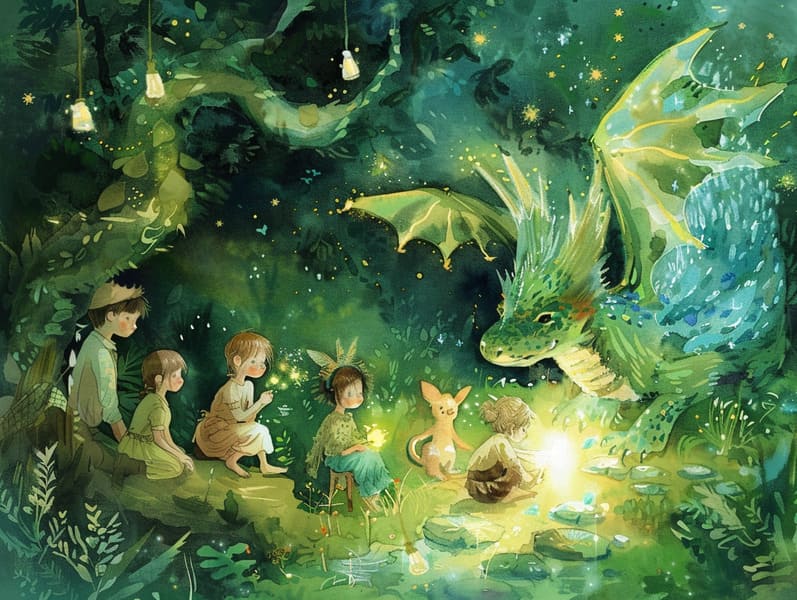
Historical fairy tales have deep roots. These narratives have been narrated from one generation to the next far before they were ever transcribed. They emerged from a variety of civilizations, including European traditions. They were initially disseminated among mature audiences, often carrying themes and messages relevant to the societal norms and beliefs of the time.
Jacob and Wilhelm Grimm, the two Grimm brothers, were among the first to assemble many of these beloved stories. Their collection, "Grimm's Story Collection," included stories like "Cinder Maid," "The Story of Hansel and Gretel," and "Little Snow White," which have since become pillars in the world of timeless fairy tales. Similarly, H. C. Andersen's fanciful fairy tales, such as "The Sea Maid," and "The Ugly Duckling," have captured hearts worldwide, ensuring their place in the pantheon of timeless fairy tales.
Even though they are old, these stories remain as impactful as ever, especially as children's bedtime stories. These enchanting tales are now available in diverse formats, including artistically illustrated books, whimsical animations, and online storybooks.
Their ongoing significance can be traced to several delightful features:
Key Lessons: Ancient fairy tales often offer important moral lessons. Stories like "The Wolf and the Liar" teach the virtue of truth, while "The Hare and the Tortoise" emphasize the benefits of steadfastness and unassuming nature. These narratives offer kids clear distinctions between virtue and vice, building their moral compass in a mild yet deep way.
Warmth and Understanding: Classic fairy tales frequently depict heroines facing struggles and tests, motivating readers to empathize with their struggles and encourage their triumphs. For instance, "The Tale of Beauty and the Beast" emphasizes the importance of looking deeper to understand the inner being of a being, cultivating empathy and appreciation.
Cultural Knowledge: Many ancient fairy tales are rich in the cultural contexts from which they arose. Understanding these fairy tales can provide fascinating glimpses into different ways of life, building a sense of cultural appreciation and recognition.
Imagination and Creativity: The supernatural elements in classic fairy tales—wizardry and magic—ignite children’s creative minds. These narratives move readers to fantastical realms, promoting imaginative thinking and a sense of mystery that continues a lifetime.
Timeless fairy tales are not only entrancing but also informative. They work as fantastical tools in cultivating various thinking and feeling skills in little ones. When timeless fairy tales are read aloud, they nurture language skills by showing new language and complicated sentence structures. This practice also boosts hearing abilities and attention span, as young ones remain attentive, enthusiastic to see what happens next.
Furthermore, analyzing the themes and characters of old fairy tales can nurture thinking skills and logical thinking. The young are taught to discern patterns, anticipate outcomes, and get cause and effect. These examinations also boost kids utter their thoughts and feelings, contributing to their emotional intelligence.
In today’s online age, the presence of internet fairy tales has made these stories more acquirable than ever. Web-based platforms and digital apps give large libraries of old fairy tales that can be browsed or listened through anytime, anywhere. Fairy tales spoken are particularly sought after, providing an engaging way for kids to relish these entrancing tales. Voice books and read-to-me videos guide characters and settings to life, often enhanced by magical audio effects and songs that improve the narrative experience.
The timeless fascination of old fairy tales lies in their ability to evolve to current times while keeping hold of their basic principles. Contemporary reinterpretations of these stories often highlight more multicultural protagonists and modern settings, making them meaningful to today’s audience. However, the core values of bravery, kindheartedness, and honesty remain unchanged, continuing to strike a chord with young readers of all ages.
Traditional fairy tales also offer a sense of protection and familiarity. They bestow a systematic narrative with a obvious beginning, middle, and end, often closing with the solving of conflicts and the triumph of good over bad. This assuredness can be relieving for young readers, distributing a sense of invariability in an ever-changing world.
Timeless fairy tales continue to fascinate and edify new generations, maintaining their elegance and significance in modern society. As kids' bedtime tales, they offer a perfect blend of captivation and insight, nurturing moral values, empathy, and creativity. The presence of web-based fairy tales and the sought after status of fairy tales told out loud ratify that these old stories remain within reach to new generations.
By maintaining and narrating these stories, we continue to appreciate the rich tapestry of cultural legacy and cultural heritage. Whether you are seeing a beautifully illustrated book, perusing a internet library, or playing an read-aloud book, the spell of Grimm's fairy tales is always within reach. These tales illustrate of the enduring nature of tales and its ability to unite us across epochs and places.
No matter if you are experiencing a colorful picture book, accessing a web-based library, or listening to an read-aloud story, the appeal of children's fairy tales is always within reach.
These stories teach us of read more the unchanging strength of storytelling and its ability to unite us across eras and regions, weaving a spell that enchants and educates alike.